|
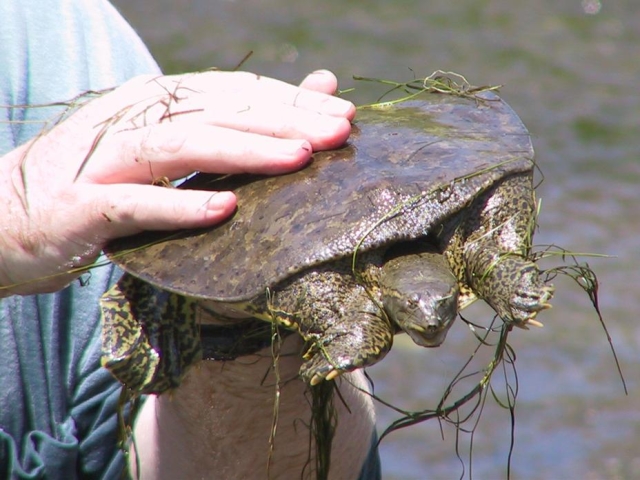
Hello. I’m Richard Lunsford, a 34 year old
Psychiatrist living, working & herping in & around Southwestern Kentucky. I live
in Hopkinsville, a city of around 33,000 people. A small river (more of a
stream, really) called the Little River runs through town in its convoluted
course. About a half hour south is Clarksville, a city of over 100,000 in
northwestern TN. The Cumberland and Red Rivers adjoin & pass through
Clarksville, which also features Dunbar Cave State Natural Area, which has a
cave system and a 15 acre water body called Swan Lake. I herp these areas fairly
often, and that’s where much of my experience lies. Of these regions, the
Little, Cumberland and Red Rivers contain softshell turtles. Wallob Hebel is a
friend, co-worker & fellow herper. Those softshells we’ve captured in Little
River have been spiny softshells, and according to Phil. Peak in Louisville, KY,
the smooth softshell is fairly rare in our region so we take those we see to be
spinies.
Why an article on herping for softshell
turtles? Why not sliders, painted turtles, common snappers or stinkpots? My
reasons vary, but here are some of the basics. Sliders are easy to find in the
wild, bask a great deal & prefer large logs that are often in open areas where
they can be spotted quickly. In areas frequented by humans they become
desensitized & you may get within 15 feet of one. Common snappers are more wary
but often encountered on land (females heading out to nest) or creeks, ditches &
mud holes (as juveniles). Stinkpots are interesting & worthwhile so perhaps
another day. But softshells are beautiful, unique & very distinct from other
turtles, wary & unlikely to be found without application of herping skills. They
have a wide range & are accessible to many people yet you can live around them
for decades & never see one. In short, they’re challenging & unusual animals
most of you have access to if you learn how it’s done.
What Are Softshell Turtles?
Softshell turtles comprise a very old, large &
wide-spread order of turtles with members in both the Old World (Eurasia,
Africa, etc…) and the New World (the Americas). In the United States, there are
3 main species:
1.)
Spiny Softshell – For many of us the mainstream softshell turtle.
A very wide-ranging species with several subspecies. Large, flattened turtles
reminiscent of pancakes with long, pointed noses. Tend to be varied gradations
of yellow & brown with dark spots or specks. Spiny softshells inhabit river
systems, large lakes and smaller water bodies (including fairly narrow, shallow
streams) that connect to rivers.
Spiny softshells have a small
proturberance on both sides of the nasal septum; smooth softshells do not. Also
notice in this photo the anterial carapacial rim spines from which the spiny
softshell takes its name.
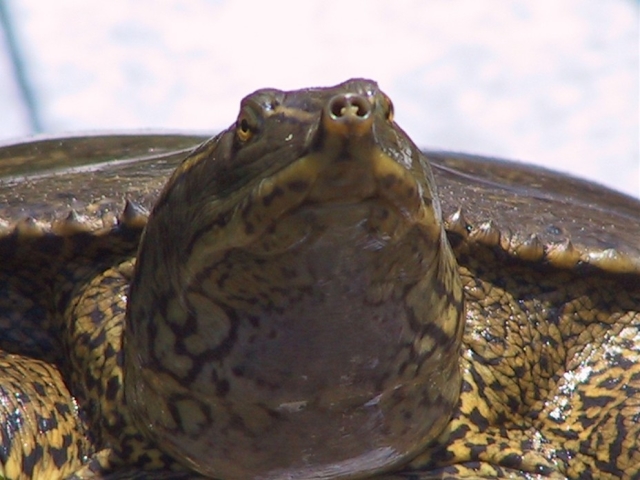
Exception:
Tom C. has noted the lack of the internasal ridge in local Guadelupe Spiny
Softshell turtles where he herps in the Ft. Worth area of Texas. Greg Brashear
likewise reports that Guadelupe softies often show up in Petco.s in his area &
they don’t seem to have the septal ridge (at least not as developed), and in
fact and they seem to not be as ‘spiny’ as their more eastern relatives.
2.)
Smooth Softshell – Like the spiny softshell it closely resembles,
a very-wide ranging species with several subspecies. Distinguishing spiny &
smooth softshells is often hard & may require capture. Males reputedly slightly
smaller than spiny males. However, smooth softies (at least juveniles) have a
reputation for not being as hardy as spiny softshells & they seem a bit less
prevalent in the pet trade.
3.)
Florida Softshell – The largest & some believe the most primitive.
The Florida softshell males approach the size of smooth & spiny females, and
Florida females are massive. Yet strangely these beasts may frequent smaller
water bodies (i.e.: ponds) than spiny & smooth softshells do. Despite being more
than most keepers will care for well over the long haul, hatchlings are common
in the pet trade as they have darker, richer color with bolder blotching than
the other North American softshells.
These fascinating turtles differ substantially
from their hard-shelled cousins. They have larger carapaces, lacking the hard
keratinized scutes of the hard-shelled turtles (so essentially the ‘shell’ is
actually covered with skin), and reduced plastrons. This style of shell is
shared with the Fly River Turtle, a similar looking but only distantly related
sole survivor having its own classification Order (and an exotic; don’t worry
about running across one unless you live in New Guinea, Australia or
thereabouts). Unlike Fly River Turtles the softshell’s carapace is often quite
flattened, contributing to the ‘pancake’ or ‘frisbee’ look. This affords them
the power to slice through water rapidly & lie on muddy banks with a low
side-view profile. Softshells are the only turtle I’ve seen with actual lips;
these are fleshy & fairly large, giving them a different ‘look’ than most
turtles, The jaws behind those lips are hard & sharp like the other turtles, and
softshells can inflict severe bites.
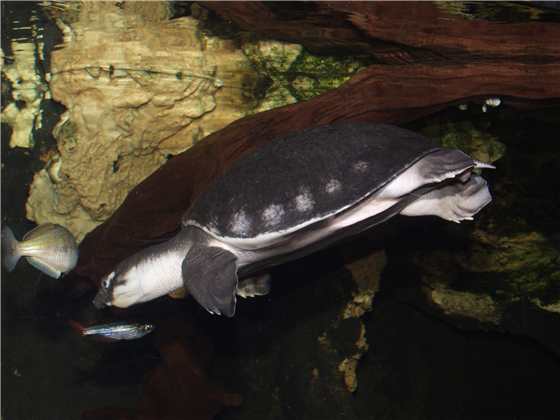
Fly
River Turtle.
How Can You Tell a Male from a Female?
There are 2 main techniques, one practical from
older juvenile stage onward, the other in adults. The first you use with
captured softies; just look at the tail. Male spiny softshells have large, long
tails almost reminiscent of a 5’th leg. Females have a respectable but somewhat
smaller tail; once you see a few of each sex the distinction will become fairly
second nature. |
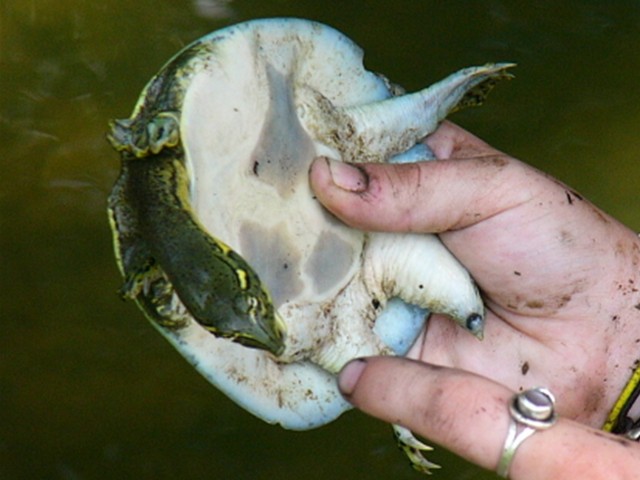 |
|
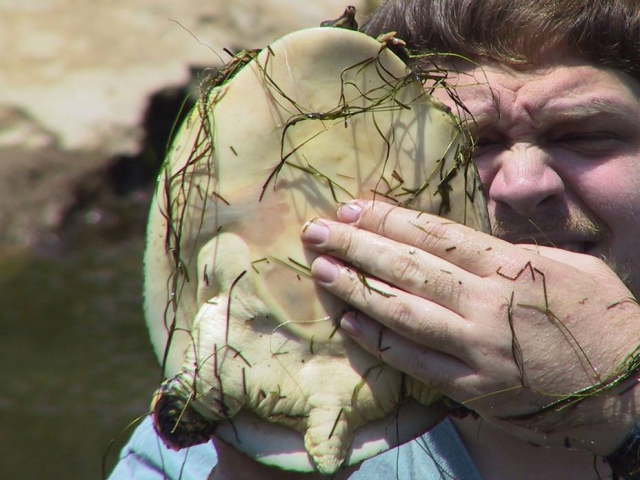 |
| |
|
|
|
Male Spiny |
|
Female Spiny |
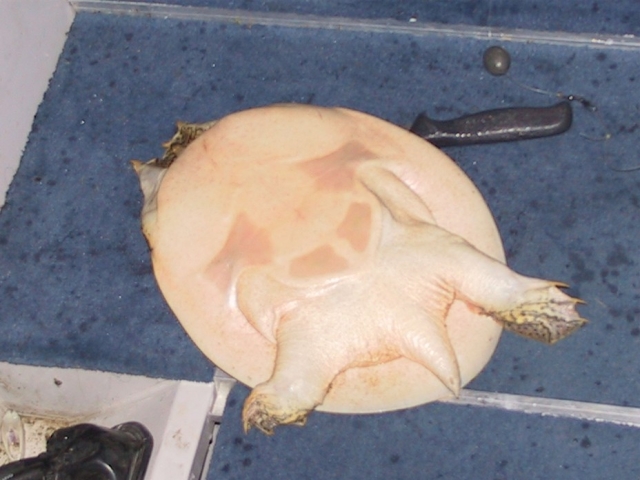
Female Spiny
(Note: laying by a knife, not stabbed)
|
The second technique is crude, useful at a
distance & requires more experience. Put bluntly, female softshells get a good
deal larger than males and when you see a really huge one, it’s a female
(although male Florida softies get pretty large). But ‘guessing’ the gender of
huge adult females is about all this is good for.
Natural Habitat of the Spiny Softshell.
As befits a very aquatically capable turtle
with poor shell-based protection, softshells are highly aquatic and at least the
spiny and smooth don’t appear prone to wonder overland as sliders & common
snappers do. Therefore, they tend to occur in rivers, large lakes and their
tributaries but not isolated farm ponds (where sliders, common snappers & mud
turtles turn up). None-the-less, they can & will occupy water bodies right down
to the size of large creeks several feet wide & perhaps a foot deep. This water
body must connect to a larger water body to allow colonization, & either be
permanent or have a nearby connection of a larger, permanent water body.
In my experience, spiny softshell turtles
prefer open water areas without a great deal of canopy overhanging the water,
with sand/mud mixture banks that aren’t too steep (moderate is okay; vertical
walls are not) and grassy growth around the bank. A sandy/muddy bottom into
which they can bury themselves is preferred. The water can be surprisingly
shallow, but when a stream dips to under a couple of feet the larger females may
move elsewhere (? Perhaps upstream?) until levels rise. Here are some habitat
examples where Wallob and I have found spiny softshells. |
Little River just
north of River Walk
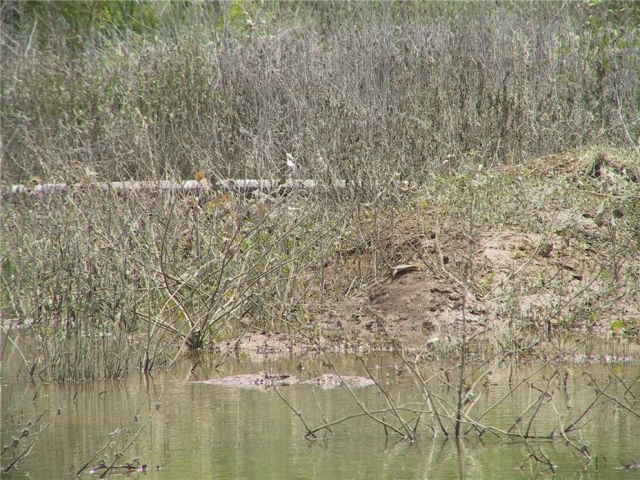
A pond-like
side-extension of Red River (There’s a softy in this shot!)
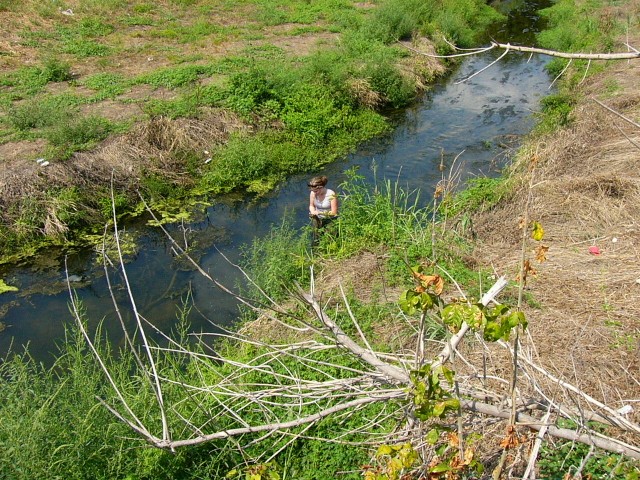
Texas Stream
Habitat
|
Herping Behavior of the Spiny Softshell.
Basking: Softshells bask
much more than is commonly supposed but seldom on the sticks & logs their
hard-shelled cousins the sliders favor. Given the ‘soft’ skin-covered shell of
the softshell, this may not be as comfortable for them (whereas sliders have a
hard plastron to bear their weight). Spiny softshells often bask on flat
surfaces such as muddy banks & large, flat rocks. They commonly bask right on
the water line, often partially in the water, where they low-profile & drab,
muddy mottled brown coloration blends well to the muddy bank. In fact, spiny
softshells along the shoreline often look like large dead magnolia leaves viewed
at an angle.
|
Basking
softshells on Little River.
|
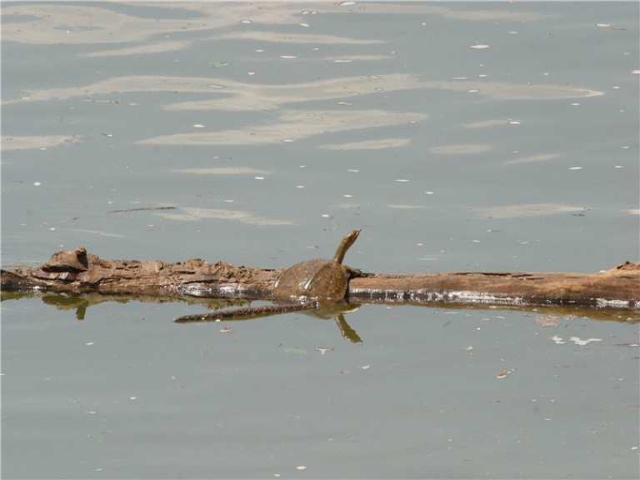
Exception that proves the rule; a softshell basking on a log drifting down the
Cumberland River near a boat dock, where the bank is covered with large, gray
rock.
In the Water: Softshells
stroll about hunting amongst vegetation mats, and may pursue fish (one of the
few turtles you may see doing this). They often lift their necks to the surface
at a bit of an angle, with the head turned at a sharp angle so the raised eyes
are above the surface film (reminiscent of an alligator’s face sitting in
water). The long, large neck & large fore-legs may give the softshells a
front-heavy appearance, and the somewhat small head tapering to a pointed nose
may make it hard for your mind to ‘register’ what you’re looking at. The first
time you see a large wild softshell you may find you can see it clearly but not
understand what you’re looking at. Due to this long-necked front-heavy
appearance & the manner they hold their heads up, softshells may make a subtle
‘bobbing’ motion in the water.
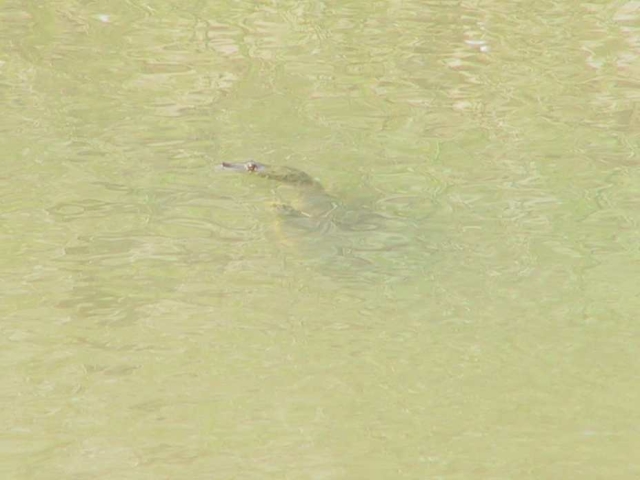
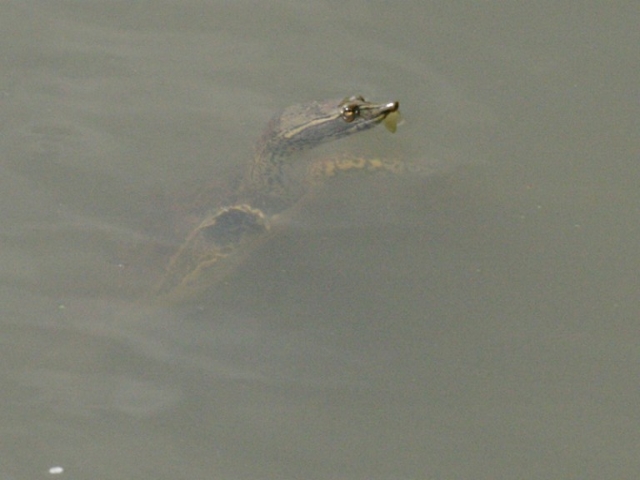
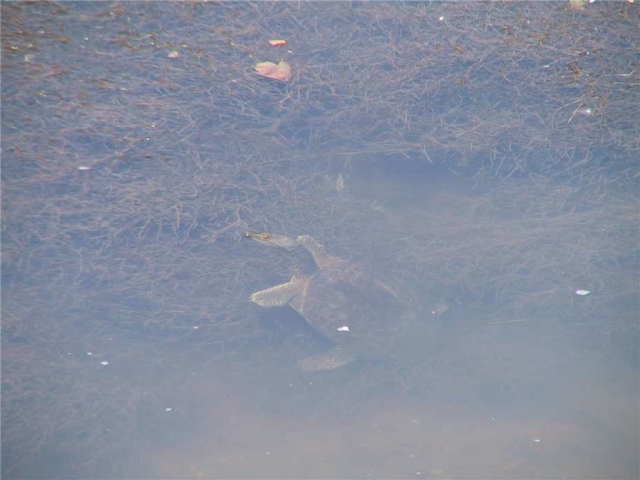
Softshells in
the Little River.
Response to Humans: A
basking softshell is very wary & may go in the water when a typical adult human
is a hundred feet away. They are bolder in the water, but still tend to submerge
when humans come within 30 feet. As with most turtles, they respond to size,
movement and noise so be quiet, move slowly & use cover when stalking spiny
softshells. You will need to stalk them; this is much different than walking
along a pond & occasionally noticing a basking red-eared slider. Remember that a
softshell lacks that hard shell protection of other turtles so paranoia is a
critical survival trait.
A Note About Hatchlings: Very young softshells may ‘hold their ground,’ or
go under & sit still when disturbed by humans, even to the point that one can go
to & catch them. Wallob Hebel has caught 2 and Richard Gould 1 this way. But
once they get past the hatchling stage they soon acquire the paranoid fervor of
their forebears.
Safety Concerns: Softshells flee first & foremost but if caught & given the
opportunity bite hard. They have strong, sharp jaws & an adult can slice through
skin & do enough damage to justify several stitches. The long neck provides good
reach for the turtle. They are strong & while their claws aren’t likely to
inflect deep lacerations, they can scratch & startle you into dropping the
turtle. If you handle a wild softshell you will likely sandwich it between your
hands, one supporting the plastron & the other pressing down on the posterior ½
to1/3 of the carapace to secure the turtle without crushing it, dropping it (due
to its kicking) or getting bitten. Unlike sliders & musk turtles who pull into
their shells & only bite if an easy opportunity presents, spiny softshells will
stick their heads out & look around for opportunities. Stay alert.
Seasonality.
I find the largest numbers of basking spiny softshells in Spring & early Summer.
When summer progresses & every day is in the high 80’s or low 90’s they are seen
but bask less often. Where I herp Little River, when water levels fall a large
female Wallob & I like to photograph disappears for awhile, presumably moving
upstream to larger, more shaded areas. While I stereotypically favor sunny days,
I have also found softshells out on cloudy days & after rains.
How To Herp for & Photograph Spiny Softshells.
1.)
Find Proper Habitat – A river, large lake or tributary from same.
Low to moderately steep sloped grassy banks with sand &/or mud & bare areas near
the water are choice.
2.)
Dress & Comport Yourself Well – Turtles can see & hear well & at
least some species can see color. Don’t wear hot orange & chat loudly with a
buddy.
3.)
Scan Ahead & Use a Viewing Aid - Walk along the bank on a stretch
giving you a good long-distance view of the near, opposite or both banks. You
must spot spiny softshells about 75 to 200 feet up ahead. You will probably need
a digital camera with a powerful telephoto lens (or powerful image-stabilized or
very stably held binoculars) to confirm their identity (until you’ve done this a
few times).
4.)
Stalk Carefully - To approach, move out of their line of site
(away from the water) & circle around to approach the water near the softshell,
using intervening barriers (trees & other vegetation) as cover. Come in slowly &
quietly. If you can put a large tree or bush between you and the turtle while
you approach, do it. You can reach around the tree to photo. without exposing
your whole body (use the tree to steady your camera, too). Turtles aren’t human
& don’t think like we do; anything you do to reduce the size of your moving
silhouette is a plus. Turtles tolerate my small friend Wallob getting close
better than me (I’m much taller & a bit more, uh, robust than Wallob.
Yeah, that’s it…robust…).
5.)
Watch the Body Language – Spiny softshells are highly alert & will
probably see you quickly. When the softy raises its head, extends its neck or
shifts position it’s considering hitting the water (which it’ll do momentarily).
6.)
Watch for Encores – At first you may think any softy hitting water
buries into the mud & stays gone for hours. Not necessarily true. Sometimes they
do hide, but if not too scared may swim just under the surface, trying to get a
better look at the disturbance (you), swim across a stream & surface
where the bank & vegetation gives them cover, & eventually return to their
basking spot. Consider hitting the site again in half an hour if they went in on
you the first time.
7.)
Photography – Ideally you should have a 640 mm telephoto
capability (17x ‘optical zoom’ in common digital camera usage, although zoom
isn’t the same as telephoto) with image stabilization. Even the greatest
telephoto compact digital cameras (Panasonic DMC-FZ1 (12x, 420 mm) & the Olympus
7x0 series (730, 740, 750 – 10x) would need a teleconverter to achieve that
(say, the Olympus TCON 17, perhaps with a ring adapter). A compact digital
camera with 10x – 12x is probably as close as most of you will get. For Digital
SLR owners, the Canon 100-400 IS & Nikon 80-400 VR lenses are good choices
(given the Canon 10D and Nikon D100 focal length multipliers that extend lens
power a great deal). That said, when you see the softy, zoom in & take a few
shots, get a few steps closer, take a few shots & so on. Odds are the turtle
will go in before you get close enough to the shot you want, so take what you
can get. You can blow the photo.s up on your computer screen later.
Can I Catch One?
There are ways to do this I’m not going into here for a few reasons. One, it can
be traumatic to the turtle. Two, a large softy can do you some real damage.
Third (& my main reason), some of you would be tempted to catch a ‘pet.’ I have
no issue with catching hatchlings or juveniles under 1 year of age for personal
pets. I do have an issue with catching sub-adults & adults for pets. Turtles in
general seem to have some aptitude for learning. Softshells are a very alert,
skittish clan that are fast & active. I am concerned a softy not raised in
captivity from a very young age is less likely to acclimate well to captivity &
human contact. I recommend you start out learning where to find them &
cultivating the skill of doing so & getting closer. There is time for learning
to actually capture & handle them later.
Richard Lunsford
With Special Thanks to Tom Coy, Wallob Hebel, (Snapper)
Greg Brashear. |
|